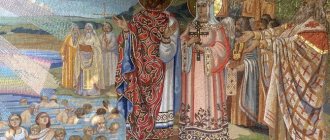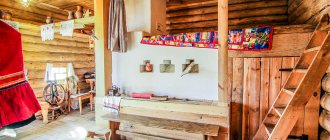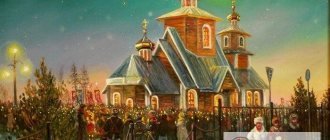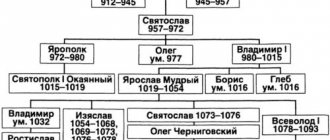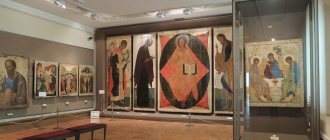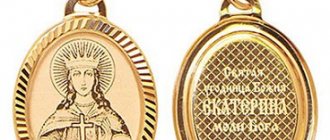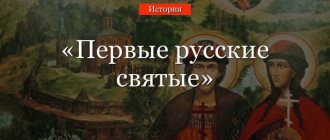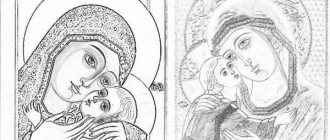A little from the history of writing early Christian icons
Since ancient times, such a pictorial culture as encaustic painting has reached Christianity. It is she who is considered the ancestor and was based on drawing with molten paints. Many early Christian icons were painted using the technique of wax tempera, one of the types of encaustic, distinguished by the richness and special brightness of the applied paint. This painting arose in Ancient Greece and then gradually reached Christianity. One of the first and most prominent icons in this style is the icon of Christ Pantocrator - the most ancient and famous image of Christ.
The legend of the appearance of the first icon
Thus, according to iconography connoisseurs, the very first icon is the face of Jesus Christ. This happened during the Way of the Cross, on the road to Golgotha, when the women wiped His face with a towel and the imprint of his face remained on the white towel. To this day, this medieval legend is called “The Handkerchief of Veronica,” taking the name of the woman who gave Him the handkerchief. It is possible that she was alone or there were several of them, but in its title the first icon mentions only the name Veronica.
The second version of the “birth” of the first icon, which is the general church one, is associated with Eastern tradition. The story of the creation of the icon tells of the artist of the king of Edessa, who was sent to depict Jesus, but the attempt was a failure. Then Jesus Christ washed himself and wiped his face with a handkerchief, on which the imprint of his face actually remained. His beard was imprinted in the form of a single strand, resembling a wedge in shape, which is probably why this icon began to be called “Savior of the Wet Brad.”
Thus, in relation to two church traditions, the first icon appeared during the years of the Savior’s earthly life, which became the icon with the name of the Savior Not Made by Hands.
The first master of icon painting
According to legend, the first man-made icon is considered to be the icon of the Mother of God, and the person who painted it was a Christian saint, one of the seventy disciples of Jesus Christ, the Evangelist Luke. In addition to painting the icon of the Most Holy Theotokos, he is credited with the icon of two holy apostles: Paul and Peter, and about seventy more icons depicting the Virgin Mary. Only three of which were written by the Mother of God herself and received their blessing during their lifetime.
These icons include: Our Lady of Smolensk, Korsun or Ephesus and Philermos. Following the legends, first the Evangelist Luke captured on the board the image of the Madonna with the Child in her arms, and then he painted two more icons, similar to the first, and took them to the Holy Mother of God. All three are significantly different from other icons of the Virgin Mary, which can provide an amazing and unique representation of what the Mother of God looked like in earthly life.
There is even an icon recreating the very process of Luke painting the icon of the Most Holy Theotokos.
In fact, no one can give a specific answer to the question of when the first icons appeared. This is all so covered with the curtain of the past that the further we move away from ancient times, the less chance we have of knowing the truth. However, not everything remains unknown. Thus, the first icons in the history of Christianity are considered to be “Veronica’s Plath” and “The Savior of Wet Brad”, which became two versions of the appearance of the first icon of the miraculous image of the Savior. And the first icon painter is considered to be the Evangelist Luke, who made a great contribution not only as the author of one of the four Gospels, but also as an artist who depicted the Blessed Virgin Mary on his canvas.
The first saints and the birth of the Russian icon
Lecture 6 of 8
Author Alexander Preobrazhensky
At the very beginning of the 13th century, shortly before the capture of Constantinople by the crusaders, a Russian pilgrim from Novgorod, Dobrynya Yadreikovich, visited the capital of the Byzantine Empire. In his “Book of the Pilgrim”, a description of the shrines of Constantinople, Dobrynya testifies that in Constantinople they were aware of the first Russian saints, the passion-bearing princes Boris and Gleb, the sons of St. Vladimir who died in 1015. The Russian traveler mentions a large icon of Boris and Gleb, which stood not just anywhere, but near the altar of Sophia of Constantinople, and a temple dedicated to the same saints in the capital suburb of Ispigas, where Boris and Gleb allegedly appeared and performed miracles. One must think that the icon of the holy princes also existed in this church.
Of course, Dobrynya drew attention to these facts primarily because we were talking about compatriot saints: against the backdrop of hundreds of churches in Constantinople and thousands of images of various saints that were there, these evidence of the veneration of Boris and Gleb were a drop in the bucket. Nevertheless, they had a certain symbolic meaning. The presence of images of Russian saints in the Byzantine capital eloquently indicated that the Russian Church, one of the youngest metropolises of the Patriarchate of Constantinople, immediately after the Baptism of Rus' by Vladimir, made its contribution to the pan-Christian treasury of holiness. Even those Byzantines who knew nothing about the life and death of the holy brothers, seeing their unusual, clearly non-Byzantine costumes and attributes, were convinced that yesterday’s “barbarians” could give the world their own saints. The customers of the Constantinople icon and the temple in Ispigas were probably Russian princes or bishops, but in this case they could not act without the sanction of the Patriarch of Constantinople. His permission meant that the lives of Boris and Gleb were recognized as worthy of imitation, the miracles attributed to them were considered genuine, and their images were perceived as reliable portraits that facilitate the communication of believers with the saints themselves and deserve veneration.
It is unlikely that the images of Boris and Gleb were widely known in Byzantium. We do not have any works that would allow us to say that the Greeks venerated the first Russian saints at a later time. Nevertheless, for the pre-Mongol era, the fate of the cult of Boris and Gleb in Byzantium seems quite successful, especially in comparison with the saints of other Orthodox territories, which, like Rus', were not part of the empire. This was apparently facilitated not only by the intense connections between Constantinople and Kiev, but also by the role of Boris and Gleb as “new”, newly revealed saints, whose remains were available for veneration and performed numerous miracles.
The glorification of Boris and Gleb took place under their brother Yaroslav the Wise, no later than the 1050s. Very quickly the passion-bearing princes began to be perceived as all-Russian saints. However, the creation of “their” cults did not stop there. By the time of the Mongol invasion, other local saints were also venerated in different lands of Rus' - or, at least, characters who could soon become such. They enjoyed varying degrees of fame, but taken together they created a fairly diverse picture, including representatives of several orders of holiness: princes, bishops and monks. So, by the middle of the 13th century, in addition to Boris and Gleb, other representatives of the ruling Rurik family were revered in one form or another - the baptist of Rus' Vladimir and his grandmother Olga. The Rostov bishop Leonty, an educator of the Rostov land and, according to some sources, a martyr who suffered from the pagans, belonged to the rank of holy bishops. His cult apparently took shape in the second half of the 12th century.
In addition to Boris and Gleb, who died during the princely strife, and Leonty of Rostov, whose biography is presented contradictory by sources, there were also “classical” martyrs in Rus' who suffered for the confession of the Christian faith. These are Theodore Varyag and his son John, who were killed in Kiev under Vladimir even before his baptism, and Abraham of Bulgaria, a Christian who died in Volga Bulgaria, but was revered in Vladimir-on-Klyazma, where in 1230 his relics were solemnly transferred.
Their own monks, that is, holy monks, also appeared early. The most famous of them were Anthony and Theodosius, who founded the famous Kiev-Pechersk Monastery and were revered already in the 12th century. They are followed by a whole host of Pechersk ascetics - heroes of the Kiev-Pechersk Patericon that developed in the first third of the 13th century. By the middle of the same century, the cult of St. Abraham of Smolensk and the Polotsk princess-nun Euphrosyne existed in some form: this is indicated by their lives, written respectively in the second quarter of the 13th century and at the turn of the 12th–13th centuries.
Pre-Mongol images of almost all of the characters listed are missing. Sometimes this can be explained by the loss of ancient monuments, which occurred for various reasons. The development of other cults and the associated artistic tradition could have been interrupted by unfavorable circumstances: in the case of Abraham of Bulgaria, such a circumstance was most likely the Mongol invasion, which undermined the power of Vladimir-on-Klyazma, and in the case of Euphrosyne of Polotsk and Abraham of Smolensk, the weakening of Polotsk and Smolensk principalities. The veneration of other saints was probably hampered by the lack of miracles from their relics, or even the absence of the relics themselves, which were not available for veneration. Since the presence of miraculous remains in the Russian tradition became an important condition for the establishment of the cult of saints, and the act of finding them actually replaced canonization, such a deficiency could seriously affect the attitude of believers towards very noticeable characters, such as the Baptist of Rus' Vladimir: miracles were not performed at his tomb, and for this reason, in pre-Mongol times, the cult of Vladimir did not develop. As for the numerous Kiev-Pechersk saints buried in the monastery caves, they were most likely perceived in general terms, as a host of ascetics whose deeds characterized not so much themselves as the Kiev-Pechersk Monastery - a place endowed with a special degree of holiness. Therefore, the individual images of these locally revered deceased were not important: the entire monastic brethren and the monastery itself were personified by its founders Anthony and especially Theodosius.
In a certain sense, one of the first popes, Clement, who died in exile in Chersonesos, can be considered among the saints who in pre-Mongol Rus' were perceived as their own, local ones. Part of his relics was transferred by Vladimir the Saint from Chersonesos to Kyiv and placed in the Church of the Tithes. The consequence of this event was the formation of a stable veneration of Clement in Rus'. It was expressed in the construction of churches dedicated to him, the creation of images and the perception of this Roman bishop as a kind of participant in the Christianization of Rus'. Another saint of the universal Church, who received a similar status quite early on, is the Apostle Andrew the First-Called, who, according to the legend included in the Tale of Bygone Years, walked through the lands of future Rus' and predicted the flourishing of the Christian faith. However, Russian depictions of these saints generally follow Byzantine standards and are not original. Much more interesting are the “portraits” of saints constructed in Rus', albeit according to Byzantine rules. This is precisely the situation, which does not occur very often, when we can talk about Rus'’s own contribution to the treasury of Eastern Christian iconography.
If we summarize the data about those Russian saints proper, whose veneration in the pre-Mongol era acquired developed forms, there will be much fewer such characters than have already been listed. First of all, these are princes Boris and Gleb, then the Kiev-Pechersk monks Anthony and Theodosius, and, finally, the Rostov bishop Leonty. There is direct or indirect information that these saints were depicted on icons, and their tombs were decorated with silver, turning into precious reliquaries (sources report silver decorations on the cancer, that is, tombs of Boris and Gleb in the temple dedicated to them in the suburbs of Kyiv - Vyshgorod and Theodosius of Pechersk in the Assumption Cathedral of the Kiev Pechersk Monastery).
Despite the paucity of data about the earliest images of this or that Russian saint, sometimes we can imagine the process of their creation. The appearance of an icon of a revered person did not require official sanction from church authorities. In addition, there were a kind of transitional pictorial forms that did not imply worship, but preserved the memory of a person. Thus, the already mentioned princess-nun Euphrosyne, the founder of the Spassky Monastery in Polotsk, by the turn of the 12th–13th centuries was already revered in her homeland, or at least in her monastery. This veneration, apparently, was of a limited nature, since there were no relics of Euphrosyne in Polotsk: she died during a pilgrimage to the Holy Land, she was buried in Jerusalem, and, according to church tradition, her remains returned to Rus' much later, under unclear circumstances, and not to Polotsk, but to Kyiv. Nevertheless, the life of the saint, as is commonly believed, was compiled no later than the beginning of the 13th century in Polotsk. It is hardly by chance that at about the same time, a small chapel in the choir of the monastery cathedral (possibly serving as the founder’s personal chapel) was painted with frescoes that had been cleared relatively recently. Their plot composition indicates that the chapel became a kind of memorial to Euphrosyne: on its walls are depicted the namesake saints of her relatives and scenes from the life of the heavenly patroness - Euphrosyne of Alexandria. Adjacent to them is the image of Euphrosyne of Polotsk, presented as the builder of the cathedral: she offers the temple to Christ who blesses her. Here the usual Byzantine scheme of the so-called ktitor portrait is used - an image of a temple builder who brings his building as a gift to God, hoping for posthumous reward. Euphrosyne does not have a halo - a sign of holiness, however, in the context of the chapel painting, her image is not just a portrait of the founder. Euphrosyne’s dialogue with Christ and the cathedral presented to him become visible evidence of a special kind of connection between Euphrosyne and God: by handing over the temple to him, she entrusts her monastery and its nuns to the care of the Lord, turning into their intercessor, praying for the monastery even after death. If, as a result of the development of the cult of Euphrosyne, after some time the nuns decided to paint an icon of her, they would certainly have used this fresco as a model, although perhaps they would not have reproduced its composition exactly.
The memory of the founders of the monasteries and the desire to have their images, which, in the event of a favorable development of events, could become authoritative prototypes for icons, was a phenomenon characteristic of Eastern Christian culture. We know well from Greek lives that intravital or posthumous portraits of ascetics—naturally, conditional in medieval times—were painted by Byzantine masters “from life” or from eyewitness accounts. This custom passed on to Rus' early on. If you believe the Kiev-Pechersk Patericon, soon after the death of Anthony and Theodosius of the Pechersk, the monastery already had their images, which were unlikely to enjoy public veneration, but were still preserved as a shrine. It was from these icons that Byzantine painters, who arrived in Kyiv in the 1080s to paint the monastery cathedral, recognized the people who negotiated with them in Constantinople to carry out the work. Of course, it was a miracle: Anthony and Theodosius, who had already been dead for several years by that time, appeared to the masters.
This very motif—recognizing a saint who has appeared by his image—is a typical commonplace in Byzantine literature. Consequently, the message of the patericon could not be believed. However, something else is more important: judging by this message, no later than the beginning of the 13th century in the Kiev-Pechersk Monastery it was believed that the images of Anthony and Theodosius had very ancient prototypes and, therefore, their replicas had a portrait resemblance to the monks themselves. It should be added that the veracity of this story is very likely, since the canonization of Theodosius of Pechersk dates back to the turn of the 11th–12th centuries: he died in 1074, and in 1091 the discovery and transfer of his relics took place. By this time, the first icons of Theodosius should have appeared, as well as, probably, images of his brother Anthony, since later they were almost always depicted together.
The history of the formation of the iconography of the Pechersk monks clearly shows that for the people of the Middle Ages, images of saints were portraits that were recognized not only by inscriptions, but also by visual features - types, hairstyles, beard shape, age characteristics, attire and attributes. This is not entirely consistent with the idea of medieval icon painting as an extremely conventional art. Meanwhile, this art is based on the powerful tradition of ancient portraiture, although it gravitates towards convention and typification of the appearance of saints.
This duality of it is well shown by the oldest image of Anthony and Theodosius of Pechersk that has survived to this day - the miraculous icon of the Mother of God of Svensk, in which the Kyiv saints are shown in prayer before the Mother of God sitting on the throne. The icon, dating back to the second half of the 13th century and created in southern Rus', apparently copies an earlier image from the Kiev Caves Monastery. Therefore, there is hardly any reason to doubt that the images of the saints follow the iconographic tradition that was formed back in the 12th or even at the end of the 11th century. It is possible that they go back precisely to those images of saints that, according to the patericon, were shown to icon painters who arrived from Constantinople. However, there is one nuance here: the appearance of the Kyiv saints on the icon of Our Lady of Svensk is very close to the appearance of their namesakes - the Egyptian hermit Anthony the Great and the Palestinian monk Theodosius the Great. Apparently, initially or over time, Anthony and Theodosius of Pechersk were consciously likened to their great predecessors, whose names they received during monastic tonsure.
If the iconography of Russian saints could depend on the iconography of saints who had long been revered in Byzantium, the question arises: how original were the oldest images of Boris and Gleb? Unfortunately, the circumstances of their creation are poorly known. Only “Reading about the life and destruction of the blessed passion-bearers Boris and Gleb” - a text of the late 11th century, written by Nestor - reports on the icon of the holy brothers, painted by order of Yaroslav the Wise for the five-domed wooden church, which was placed in Vyshgorod over the relics of the saints. The author of the “Reading” specifically talks about the nature of the image: believers, contemplating the icon, saw, as it were, Boris and Gleb themselves. However, these words reflect the most general ideas about the historicity of icons of saints, characteristic of both Byzantine and Old Russian culture.
Yaroslav's construction of the wooden Boris and Gleb Church in Vyshgorod meant that Boris and Gleb were recognized, if not all-Russian, then as locally revered saints. This event most likely occurs in the 1040s. The creation of the first icons of Boris and Gleb, which, apparently, were executed by Byzantine masters, can also be dated to the same time (it is unlikely that by this time Rus' had its own qualified icon painters worthy of fulfilling the princely order). The hagiographic texts emphasize that the relics of the brothers were found incorrupt. If we trust this news, we can assume that the icon painters were guided by the appearance of the relics (similar cases are known at a later time). However, another version also seems possible: not much time had passed since the death of Boris and Gleb, and there were still people alive who remembered what they looked like (Boris and Gleb’s brother, Yaroslav, was such a witness). It is hardly accidental that in one of the texts of the Boris and Gleb cycle - “Tales and Passions and Praise to the Holy Martyrs Boris and Gleb” - a description of Boris’s appearance is given. It contains fairly general information, but some more specific details may be reliable. In particular, the Legend reports that Boris had a small beard and mustache since he was still young. The visual tradition has preserved this feature. As for the even younger Gleb, he is depicted as beardless and long-haired. Sometimes Boris was also depicted as beardless. This deviation from the norm can be explained by the desire to liken the brothers to each other, to emphasize their youth and purity, showing that both of them became pure sacrifices to God. Nevertheless, the “asymmetrical” version of iconography with its complex dramaturgy, based on the contrast of the age characteristics of the saints and the emotional content of their images, turned out to be more popular. This principle finds parallels in "The Tale and Passion and Praise of Boris and Gleb", where Boris appears more courageous than his younger brother, begging the murderers to spare his youth.
One of the most important elements of early images of Boris and Gleb is their clothes. It is they who make the iconography of the first Russian saints an extremely original phenomenon. The fact is that the images of Russian monks or bishops did not actually differ from the images of Byzantine saints who belonged to the same ranks of holiness, since both were depicted in the same monastic or episcopal robes. Meanwhile, the iconography of Boris and Gleb is very clearly tied to ancient Russian realities. The masters who developed it did not try to liken the sons of Vladimir to the Byzantine emperors or Old Testament kings, who were usually depicted in the Byzantine imperial costume. Boris and Gleb also do not resemble the martyrs presented in Roman patrician robes. Obviously, at the insistence of the customer of the first icon of Boris and Gleb, they were presented in the clothes of Russian princes - long belted shirts, characteristic cloaks with a triangular panel covering the front of the figure, and round or conical hats with a fur trim.
The historical authenticity of this costume is easily proven by comparing early images of Boris and Gleb with portraits of Russian princes of the 11th–12th centuries. These princes, presented as commissioners of temples or manuscripts, are dressed in similar robes, which may have both Slavic and Scandinavian roots. However, whatever the origin of such clothes, they look completely un-Byzantine, and therefore the icon of Boris and Gleb, which by the beginning of the 13th century was in the Church of Hagia Sophia in Constantinople, undoubtedly stood out very much from the background of the images surrounding it. A monument has reached us that allows us to reconstruct this effect. In the 1220s, the figures of Boris and Gleb were included in the paintings of the Serbian monastery of Mileshevo - most likely created by Greek artists. The latter, clearly using the Russian model, quite accurately reproduced the princely clothes and hats. It is not surprising that the resulting result turned out to be very far from both the neighboring images of other saints, and from the portraits of members of the Serbian Nemanjic dynasty located in the same temple.
We can say that the formation of such a recognizable appearance of Boris and Gleb summarizes several trends. On the one hand, the historicity and authenticity of the appearance of the holy brothers and, in particular, their attributes do not contradict the methods of iconographic creativity characteristic of Byzantine art. On the other hand, the result turns out to be so non-Byzantine that one would like to compare the images of Boris and Gleb with the images of holy rulers revered in Northern, Central and Eastern Europe - Vyacheslav (Vaclav) of Bohemia, Olaf of Norway, Stephen of Hungary and others. The iconography of these saints, revered by Christians of the Latin tradition, but typologically close to the “Orthodox” Boris and Gleb, was not associated with Byzantine or Western imperial iconography. However, it had other advantages: recognition and connection with local realities, which made obvious the similarity of the holy kings with their descendants - representatives of the same dynasty.
Images of Boris and Gleb were perceived by viewers in a similar way. The appearance of the holy princes, exotic from the point of view of the Byzantines, was normal for the inhabitants of Rus' and even more so for the relatives of Boris and Gleb - princes from the Rurik family. But it was this normality that mattered. The similarity of the icons of the holy brothers with the appearance of real Russian rulers who wore the same cloaks korzna Korzno - a princely cloak or mantle, fastened with a fibula cufflink on the right shoulder. and hats, testified that Boris and Gleb are “their” saints for the Russian princely dynasty and the entire Russian land. The appearance of the iconography of Boris and Gleb in Russian princely robes partly explains why the princes of the second half of the 11th - 12th centuries did not try to borrow the attributes of the Byzantine emperors, as did Vladimir the Saint, who appears in the imperial crown on his coins. The Rurikovichs had not just holy relatives, but ideal ancestors, as if sanctifying with their authority the ancestral traditions and even the appearance of the Russian prince.
Despite the obvious connection between the images of Boris and Gleb with the image of the ideal prince Rurikovich, the iconography of the holy brothers initially had a slightly different content. A series of famous icons of Boris and Gleb, dating back to the 13th–14th centuries, depicts them with swords, which were not only weapons, but also one of the signs of princely power. Meanwhile, this is a relatively late detail, which became widespread starting from the turn of the 12th–13th centuries and, obviously, reflected the veneration of Boris and Gleb as defenders of Rus'. In earlier works, the brothers are presented unarmed: in their hands there are only crosses, indicating the martyrdom of the saints. This version of iconography is comparable to the texts of the Boris and Gleb cycle, which describe the miracles of the brothers: these are miracles not of a military, protective nature, but mainly of healing the sick. Consequently, the cult of brothers was not perceived as exclusively military or dynastic.
The evolution of the iconography of Boris and Gleb from the image of martyred princes to the image of warrior princes is interesting not only in itself, but also as proof that ideas about the first Russian saints were not frozen. On the contrary, during the pre-Mongol era this plot was rethought more than once. This is not surprising if we consider that by the 12th century, in addition to Vyshgorod, where the main Boris and Gleb temple was located, which kept the relics of the brothers, there were other churches dedicated to them in different lands of Rus' - for example, temples built in the places of death of both princes. There is almost no information about the decoration of these long-dead buildings. However, even the fragmentary material that has survived from the 11th–13th centuries allows us to speak of a wide variety of works and their functions. Images of Boris and Gleb are found in icon painting and in temple paintings, in manuscript miniatures, in stone icons, on copper reliquary crosses and on cloisonne enamels, on the seals of princes who bore the name Boris or Gleb. In addition to those compositional options that have already been discussed, by the end of the 12th century there were others. These are, for example, the images of Boris and Gleb, who hold in their hands the temples dedicated to them, acting as their patrons and, in a figurative sense, founders (a situation completely atypical for Byzantine art, where their real builders were depicted with temples in their hands). These are images of Boris and Gleb on horseback, apparently based on a hagiographical story about the appearance of equestrian saints. Thanks to Russian cultural influence, they even reached the Baltic island of Gotland - Russian saints in the form of horsemen are represented in a late 12th-century painting in one of the local churches. There is reason to think that already in the 12th century there were pictorial cycles that illustrated texts about Boris and Gleb.
Such activity of iconographic creativity, characterizing the culture of pre-Mongol Rus', anticipates and explains the richness of the Russian visual tradition of the 14th–17th centuries, when there would be many more “own” saints in Rus'. The history of Russian holiness begins in the pre-Mongol era, and it was at this time that many iconographic themes were born, which subsequently gained great popularity. Their appearance would have been impossible without a solid Byzantine base, which included both the theory of the iconic image and the practical principles of creating a portrait of a saint. However, due to the fact that Rus' never sought to reproduce Byzantine culture in its entirety and early formulated its own preferences, the appearance of its early saints is specific and recognizable. Subsequently, it will change more than once, as happened with the iconography of Boris and Gleb. But these changes will still occur within the framework of the Byzantine iconographic paradigm and with an eye on Russian realities.
“The Business of Icon Making”, or How Icons were Painted in Rus'
Date of publication: October 26, 2018
Ancient Rus' did not know such an art form as painting. The first picturesque images in Rus' were icons. Old Russian icon painting is rightfully considered the best in the world. And although icon painting as an art, together with its canons, came to Rus' from Byzantium, ancient Russian icon painting soon became distinctive. Originating in the 10th century, it remained the core of ancient Russian culture until the 17th century.
LiveInternetLiveInternet
Sunday, January 08, 2012 04:16 + in the Lenyr
all posts by the author
Arhangel Mihail Icon painting in Ancient Rus' was a sacred matter. Strict adherence to canonical instructions, on the one hand, impoverished the creative process, since it limited the possibilities of self-expression of the icon painter, since the iconography of the image, as a rule, was already given, but, on the other hand, forced the artist to focus all his skill, all his attention on the essence " spiritual object”, on achieving deep penetration into the image and recreating it with exquisite visual means.
Ikona Strashny Sud Traditions and established techniques affected not only iconography, but also the choice of material on which icons were painted, the substance of the soil, the method of preparing the surface for painting, the technology of making paints and, finally, the sequence of writing. When painting icons in Ancient Rus', paints were used in which the binding medium was an emulsion of water and egg yolk - tempera.
Apokalipsis_XVI_ Icons were most often painted on wooden boards. Usually they took boards from linden, in the North - from larch and spruce, in Pskov - from pine. The board, as a rule, was hewn out of a log, choosing the strongest inner layer of the tree trunk. This process was labor-intensive and lengthy.
Arh Gavriil Deis_ Boards for icons were made by woodworkers or woodworkers, rarely by icon painters themselves. A shallow recess was usually made on the front side of the board - an ark, bounded along the edges of the board by fields slightly rising above it. For small icons one board could be used. For large icons, several boards were connected. The nature of the fastening, the depth of the ark and the width of the fields often make it possible to determine the time and place of manufacture of the icon board. The fields of ancient icons of the 11th-12th centuries are, as a rule, wide, and the ark is deep. Later icons have narrow margins, and from the 14th century icons were sometimes painted on boards without borders.
Arh Mihail Popir Diavola Gesso was used as a primer, which was prepared from chalk or alabaster and fish (sturgeon) glue. The icon board was coated several times with liquid hot glue, then the pavolo was glued on, rubbing it in with the palm of the hand. After the pavolok had dried, gesso was applied. The gesso was applied in several stages, in layers. The surface of the gesso was carefully leveled and sometimes sanded. Sometimes relief was applied to the gesso. In ancient icons, starting from the 12th century, “chasing” was often done on gilded gesso. Sometimes such patterned embossing was done on halos. In later times (from the 16th century), to create an in-depth (or relief) pattern, gesso carving was carried out before writing began. Then the relief was gilded.
Chudo Archangela Mihaila A drawing was made on the prepared soil surface. First, the first drawing of the images was performed, and then the second, more detailed one. The first drawing was done by lightly touching soft charcoal from birch branches, the second - with black or brown paint.
Grad Jerusalem Some icons were reproduced from “originals” or from copybooks obtained from icons that served as samples. After this, the actual writing began. At first, everything that was required was gilded: the fields of the icon, lights, crowns, folds of clothing. Then the pre-letter writing was done, that is, clothes, buildings, and landscapes were painted. At the final stage of creating the icon, the faces were painted. The finished image was covered with a special kind of oil varnish - “oiled”.
Ikona BOmOmilen The paint work was carried out in a strictly defined sequence. Both the icon writing and its sequence were not the same in different icon painting schools and changed over time. First, the areas limited by the contours of the design were covered with thin layers of appropriate paints in the following order: background (if it is not gold), mountains, buildings, clothes, exposed parts of the body, faces. After this, whitening was done, which highlighted the convex details of objects (except for faces and hands). Gradually adding white to the paint, smaller and smaller areas of highlighting were covered. The final touches were applied with pure white. To create greater volume of the image, a thin layer of dark paint was applied to the darkened and recessed areas. After dark paint, all facial features and hair were drawn in thin lines.
Ikona ChudOmir Fedora Then light highlights were applied to the convex parts of the face: forehead, cheekbones, nose, strands of hair using white or ocher with a large addition of white. Then the “blush” was applied. A thin layer of red paint was applied to the lips, cheeks, tip of the nose, in the corners of the eyes, and on the earlobes. After this, the pupils of the eyes, hair, eyebrows, mustache, and beard were drawn in with liquid brown paint.
Samples—“originals”—served as a guide to painting icons. The originals contained instructions on how this or that image should be painted. Tempera painting requires virtuoso technique and a high level of writing culture. This was achieved over many years of apprenticeship. Icon painting was a great creativity. The isographer specially prepared to carry out the “work of icon making.” This was an act of communication with another world and required spiritual and physical cleansing, when everything carnal was suppressed as much as possible: “... when he painted the holy icon, he touched food only on Saturdays and Sundays, not giving himself rest day and night. He spent the night in vigil, prayer and prostrations. During the day, with all humility, non-covetousness, purity, patience, fasting, love, and God-thinking, he devoted himself to icon painting.”
Successfully painted images were considered to have been painted not by an icon painter, but by God. Very few names of ancient Russian artists have survived. After all, it was believed that God himself painted the icon with the hands of icon painters, and therefore it seemed inappropriate to name the name of the person whose hands God used. On the other hand, icon painting was truly an intimate communication with another world, and there was no need to name oneself: after all, God himself knows the one who creates the image, or rather, prayerfully and humbly tries to reproduce the prototype.
The Byzantines believed that the meaning of any art was beauty. They painted icons, shining with gilding and bright colors. Each color had its own place, its own meaning. The colors were never mixed, they were light or dark, but always pure. In Byzantium, color was considered as important as a word, because each of them had its own meaning. One or more colors created a speaking image. Studying from the Byzantines, Russian master icon painters accepted and preserved the symbolism of color. But in Rus' the icon was not as magnificent and austere as in imperial Byzantium. The colors on Russian icons have become more vibrant, bright and sonorous. The icon painters of Ancient Rus' learned to create works that were close to local conditions, tastes and ideals.
Golden color The golden shine of mosaics and icons made it possible to feel the radiance of God and the splendor of the Heavenly Kingdom, where there is never night. The golden color signified God himself. This color shines in various shades on the icon of the Vladimir Mother of God.
Purple The color purple, or crimson, was very important in Byzantine culture. This is the color of the king, the ruler - God in heaven, emperor on earth. Only the emperor could sign decrees in purple ink and sit on a purple throne, only he wore purple clothes and boots (this was strictly forbidden to everyone). Leather or wooden bindings of the Gospels in churches were covered with purple cloth. This color was present in the icons on the clothes of the Mother of God - the Queen of Heaven.
Red Color Red is one of the most prominent colors in the icon. This is the color of warmth, love, life, life-giving energy. That is why red has become a symbol of the Resurrection - the victory of life over death. But at the same time, it is the color of blood and torment, the color of Christ’s sacrifice. Martyrs were depicted in red robes on icons. The wings of the seraphim archangels close to the throne of God shine with red heavenly fire. Sometimes they painted red backgrounds - as a sign of the triumph of eternal life.
White color White color is a symbol of Divine light. It is the color of purity, holiness and simplicity. On icons and frescoes, saints and righteous people were usually depicted in white as the Righteous - people who are kind and honest, living “in truth.” The same white color shone with the shrouds of babies, the souls of dead people and angels. But only righteous souls were depicted in white.
Blue and light blue colors Blue and light blue colors meant the infinity of the sky, a symbol of another, eternal world. Blue color was considered the color of the Mother of God, who united both earthly and heavenly. The paintings in many churches dedicated to the Mother of God are filled with heavenly blue.
Green color Green color is natural, living. This is the color of grass and leaves, youth, blossoming, hope, eternal renewal. The earth was painted with green; it was present where life began - in the scenes of the Nativity.
Brown color Brown is the color of bare earth, dust, everything temporary and perishable. Mixed with the royal purple in the robes of the Mother of God, this color recalled human nature, subject to death.
Black color Black color is the color of evil and death. In icon painting, caves—symbols of the grave—and the yawning abyss of hell were painted black. In some stories it could be the color of mystery. For example, on a black background, signifying the incomprehensible depth of the Universe, the Cosmos was depicted - an old man in a crown in the icon of the Descent of the Holy Spirit. The black robes of monks who have retired from ordinary life are a symbol of the renunciation of former pleasures and habits, a kind of death during life.
A color that has never been used in icon painting is grey. Having mixed black and white, evil and good, it became the color of obscurity, emptiness, and nothingness. This color had no place in the radiant world of the icon. The faces of saints on icons are faces, that is, the faces of those who are outside of time, who are in eternity. And that is why individual facial features, understood as random attributes of temporary earthly life, are left only as signs necessary for recognition. The face is a face that has been freed from the seal of worldly passions and idle worries and has acquired the status of a visible symbol of the accomplished spiritual transformation.
One or another saint can be recognized or distinguished only by a canonized set of signs (book, clothes, beard, mustache, etc.). This set is a kind of iconographic constant, a code that is reproduced and repeated without changes when a given saint is depicted on different icons in different eras.
But icons do not glorify the flesh, as the art of pagan antiquity did. They recreate only those visible features that express the invisible properties of the Prototype, such as humility, kindness, tolerance, non-covetousness, meekness. As one of the church fathers, Gregory of Nyssa, said: “Divine beauty is not manifested in any external form and not in the charm of an external image, determined by any elegance of colors, but is seen in ineffable bliss in accordance with virtue.” Icon painters and illustrators of ancient handwritten Christian books were convinced of the imperfection of human vision, which cannot be trusted because of its carnal nature, and therefore considered it obligatory for themselves to try to depict the world not as they see it, but as it really is . The question of what the world really is like could only be resolved speculatively, when not the experience of earthly bodily life, but the dogmas of faith, are accepted as an axiom.
Those who look for external beauty in an icon are mistaken. Church creativity has a slightly different understanding of beauty. Spiritual beauty is higher than physical, and the goal of Christian life is to ascend to the Primary Source of beauty - God. Nature is one of the means of knowing God; through the contemplation of its beauties, man is called to glorify God the Creator and create the beauty of his inner image, growing and being renewed in Christ into a new creation, transformed, redeemed for a new, Eternal Life in Christ. But it is very difficult for a person to think spiritually in earthly conditions, and the Church has established a certain mediation, like a bridge from the material to the spiritual world, by creating a symbol - a visual image of the truths of faith, and at the same time developing special forms, unique to it. This is an ancient icon. Therefore, before the icon, “we do not worship the written face in prayer, but ascend to the Prototype.”
The language of an icon is the same as a letter. The child is first taught to write individual letters, then is given the opportunity to copy from a book, then to write an exposition and, finally, an essay. Likewise, icon painting has its own literacy, its own school, its own sequence of work, through which the student is given special knowledge, special training and special education. The program and gradual training are also traditional and proven by the experience of many generations. “As a kind of revelation of God, as the fruit of spiritual experience, as the tradition and creation of the Fathers of the Church, as their testimony to eternity, the ancient icon bears all the features of heaven: undistracted prayerful composure, the depth of the mysteries of faith, harmony of the spirit, the beauty of purity and dispassion, the greatness of humility and simplicity , fear of God and reverence. The passions and bustle of the world calm down before her; it rises above everything in a different plane of existence. An icon is a great shrine both in content and in form. Some icons are written by the finger of God, some by Angels. Angels served icons, carrying them from place to place (Tikhvin Icon of the Mother of God, etc.); many remained unharmed in the fires; some, being pierced by spears and arrows, shed blood and tears, not to mention countless other signs, such as healings and so on. The Gospel preaches the Kingdom of God in word, the icon communicates the same thing in an image.”
Author: NATAX
[/td]
| "lady mistress" |
| Categories: | Russian creators painting applied art |
Tags:
applied arts painting Russian creators Icons Religion
Cited 50 times Liked by: 16 users
Like share
0
Like
- 16
I liked the post - Quoted
- 0
Saved
- Add to quote book
- 0
Save to links
Liked16
0
